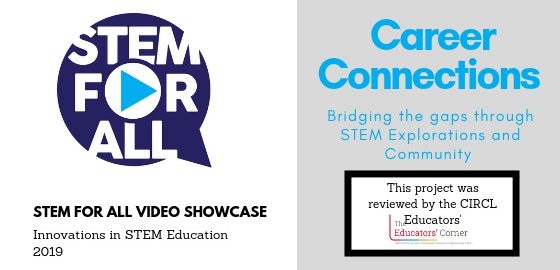By Angie Kalthoff
I’ll be doing a series of blog posts around videos I from the NSF 2019 Video Showcase. The Bridging the gaps video caught my attention because I worked with underserved and underrepresented students for many years. As a technology integrationist, I was constantly thinking about how I could connect students and their families with careers they may not know about–maybe even careers in our own community. Based on our goal of connecting with the community, during the Hour of Code celebration in December, we created Community Code. Community Code was a way to bring people from our community into our classrooms to share their jobs and how technology is used in their workplace.
In addition, some local businesses and universities hosted family nights and offered a variety of activities for families to engage with. The goal was to connect our community with our classrooms from kindergarten through senior high school. As I watched the video, I became interested in learning more about this project because of the segment where students and community members shared their experiences.
Overview of the Program
i3STEM is a project focusing on “inquiry based extended learning opportunities for underserved and under-represented middle school student populations.” This program includes hands on STEM explorations and collaborative events with community partners for college and career connections. Researchers on this project are working to increase an interest in STEM through the events that are offered to the underserved and under-represented students in Metropolitan Nashville Public Schools. Their goal is to grow academic achievement in science and math and increase STEM awareness with the outcome of more students going into STEM careers. “STEMgineers”, students in the program, shared experiences about field trips, activities, and how they are now inspired to be future computer scientists, geologists, and science teachers! Kids who have faced challenges in the traditional classroom have now been able to participate in an experience that made them feel empowered and successful. Students were excited about the experiences they had with their community partners. The video shows how connections that were once difficult to make were turned into real life learning opportunities. Researchers close the video with a statement sharing how the experiences the students had are helpful for the whole child and not just for academics.
The Goal of the Program
Career Connections: Bridging the gaps through STEM Explorations and Community Partnerships offers extended learning opportunities to underrepresented schools. Their goal is to improve academic achievement in science in math, increase awareness and interest in stem in hopes that their students will pursue STEM related careers.
Outcome of the Program
A few of the main points researched include:
- Attendance and participation in learning opportunities
- Student views and interests in STEM or pursuing a STEM career
- Student scores in math and science
- Academic/observation scores for teachers in the program
They shared positive results in the Stem For All Showcase discussion; those included:
- 73% of the students entering high school chosea STEM academy
- 75% of students expressed an interest in pursuing a STEM related career
- Academic gains for students in both math and science doubled from one year to the next
- 73% of the teachers in the program have maintained or increased state standardized testing scores based on their students’ performance.
My thoughts on how this could be used in practice
After viewing their i3STEM website, I was able to see numerous activities that were implemented in their classes. Some of the activities were similar to what I’ve done in classrooms while some were brand new to me. For example, the Mystery Bag STEM pdf, includes cards that you can print off and add to a bag with resources for students to complete a project. Other projects include:
- “As part of the Homestead Act, you are required to cultivate your many acres of land. Using only the items in your bag, engineer a technology to help with that task.”
- “Production costs for your “Fancy Fidget” have gone up. Using the items in your bag, engineer an interesting fidget toy that costs less than .75 to build.”
The way the website is organized makes it easy for viewers to find what they are looking for based on the following categories:
- Teacher Resources
- Student Resources (which were used for their project, probably less helpful for you)
- About Us
– Here you can find lesson plans, links to helpful videos, and a teacher guide.
– Student survey links, links to resources for local issues, help for choosing topics, and resources for projects.
– Shares contact information for the project, information about the schools and sponsors, and an over of the project evaluation.
I found their resources and thinking really helpful. I think this is a great way to create a bridge between community and education.
We’d love to hear from you — Tweet to @CIRCLEducators or use #CIRCLEdu.
How to cite this work
CIRCL Educator posts are licensed under a Creative Commons Attribution 4.0 International License. If you use content from this site, please cite the post and consider adding: "Used under a Creative Commons Attribution 4.0 International License (http://creativecommons.org/licenses/by/4.0/)."
Suggested citation format: [Authors] ([Year]). [Title]. CIRCLEducators Blog. Retrieved from [URL]

